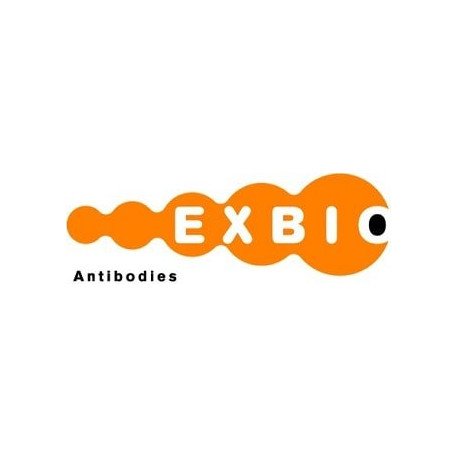Cart 0 Product Products (empty)
No products
To be determined Shipping
0,00 € Total
Prices are tax excluded
Product successfully added to your shopping cart
Quantity
Total
There are 0 items in your cart. There is 1 item in your cart.
Total products (tax excl.)
Total shipping (tax excl.) To be determined
Total (tax excl.)
Data sheet of Rat Monoclonal to CD9 (mouse)
| Brand | Exbio |
| Product type | Primary antibodies |
| Reactivity | Mouse |
| Clonality | Monoclonal |
More info about Rat Monoclonal to CD9 (mouse)
| Brand: | Exbio |
| Product no.: | 11-567-C100 |
| Product type: | Primary antibodies |
| Host species: | Rat |
| Product name: | Rat Monoclonal to CD9 (mouse) |
| Antigen: | CD9 (mouse) |
| Clonality: | Monoclonal |
| Clone: | EM-04 |
| Isotype: | IgG1 |
| Immunogen: | Permeabilized murine bone marrow-derived mast cells (BMMC)._x000D_ |
| Format: | purified |
| Specificity: | The rat monoclonal antibody EM-04 recognizes CD9 antigen, a 24 kDa transmembrane protein expressed on platelets, monocytes, pre-B lymphocytes, granulocytes and activated T lymphocytes._x000D_ |
| Categories: | CD and Related Antigens & MHC (Rodent) |
| Concentration: | 1 mg/ml |
| Storage buffer: | Phosphate buffered saline (PBS) with 15 mM sodium azide, approx. pH 7.4 |
| Storage / stability: | Store at 2-8°C. Do not freeze. Do not use after expiration date stamped on vial label. |
| Background: | CD9 belongs to proteins of tetraspanin family that orchestrate cholesterol-associated tetraspanin-enriched signaling microdomains within the plasma membrane, forming complexes with each other as well as with integrins, membrane-anchored growth factors and other proteins. CD9 is involved in cell motility, osteoclastogenesis, neurite outgrowth, myotube formation, and sperm-egg fusion, plays roles in cell attachment and proliferation and is necessary for association of heterologous MHC II molecules on the dendritic cell plasma membrane which is important for effective T cell stimulation. CD9 is also considered as metastasis suppressor in solid tumors. |
| Purity: | > 95% (by SDS-PAGE) |
| Purification: | Purified by protein-A affinity chromatography |
| Product specific references: | *Athman JJ, Wang Y, McDonald DJ, Boom WH, Harding CV, Wearsch PA: Bacterial Membrane Vesicles Mediate the Release of Mycobacterium tuberculosis Lipoglycans and Lipoproteins from Infected Macrophages. J Immunol. 2015 Aug 1;195(3):1044-53. |
| General references: | *Kotha J, Zhang C, Longhurst CM, Lu Y, Jacobs J, Cheng Y, Jennings LK: Functional relevance of tetraspanin CD9 in vascular smooth muscle cell injury phenotypes: a novel target for the prevention of neointimal hyperplasia. Atherosclerosis. 2009 Apr;203(2):377-86., *Liu WM, Cao YJ, Yang YJ, Li J, Hu Z, Duan EK: Tetraspanin CD9 regulates invasion during mouse embryo implantation. J Mol Endocrinol. 2006 Feb;36(1):121-30._x000D_ _x000D_ _x000D_ , *Le Naour F, Rubinstein E, Jasmin C, Prenant M, Boucheix C: Severely reduced female fertility in CD9-deficient mice. Science. 2000 Jan 14;287(5451):319-21._x000D_ _x000D_ _x000D_ , *Schmidt C, Künemund V, Wintergerst ES, Schmitz B, Schachner M: CD9 of mouse brain is implicated in neurite outgrowth and cell migration in vitro and is associated with the alpha 6/beta 1 integrin and the neural adhesion molecule L1. J Neurosci Res. 1996 Jan 1;43(1):12-31._x000D_ , *Unternaehrer JJ, Chow A, Pypaert M, Inaba K, Mellman I: The tetraspanin CD9 mediates lateral association of MHC class II molecules on the dendritic cell surface. Proc Natl Acad Sci U S A. 2007 Jan 2;104(1):234-9. |
| Related products: | - Hamster Monoclonal to Bim (mouse) - Rat Monoclonal to Ly6G (mouse) - Rat Monoclonal to MHC Class II (mouse) |
| Shipping condition: | Room temperature |


